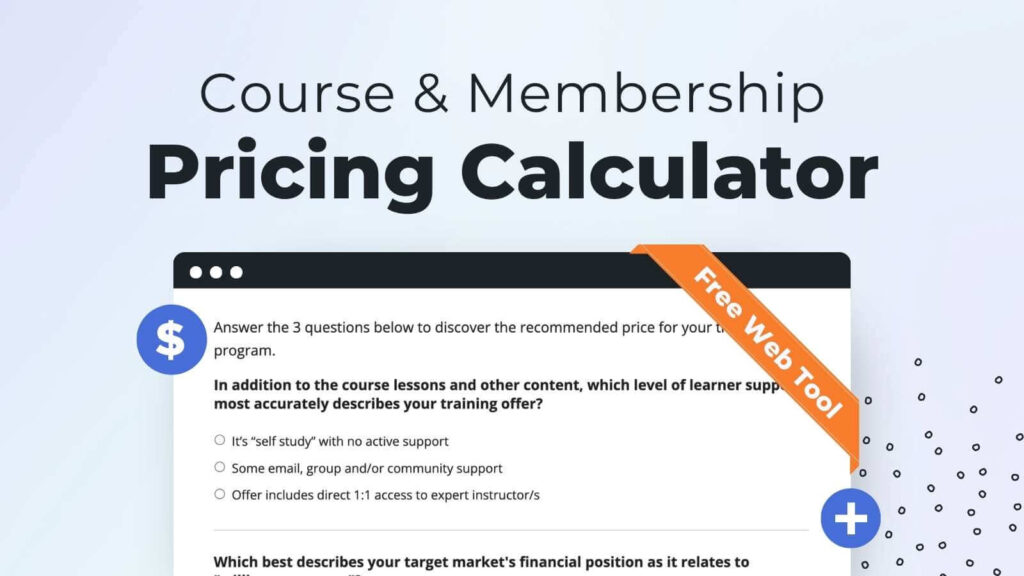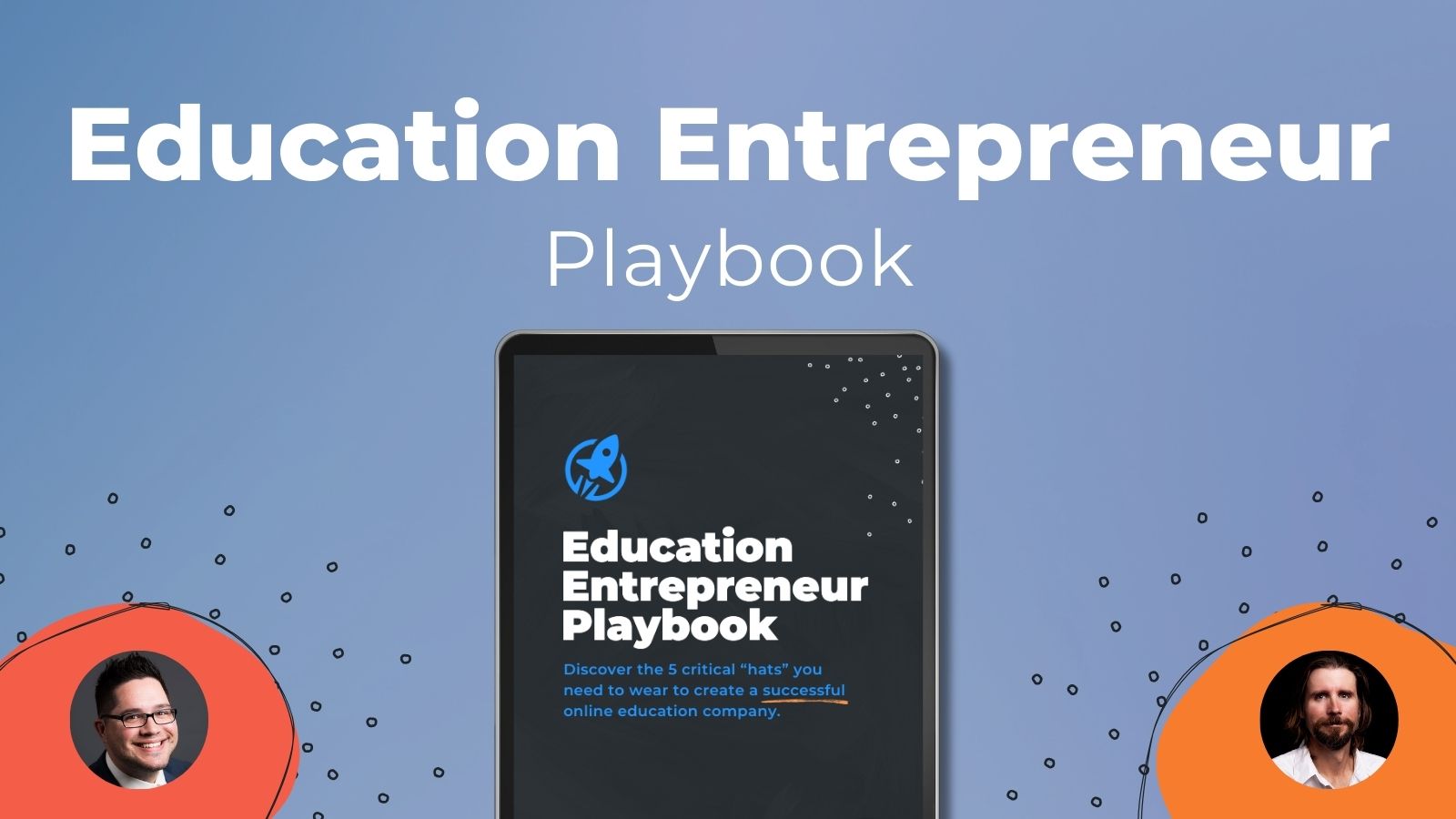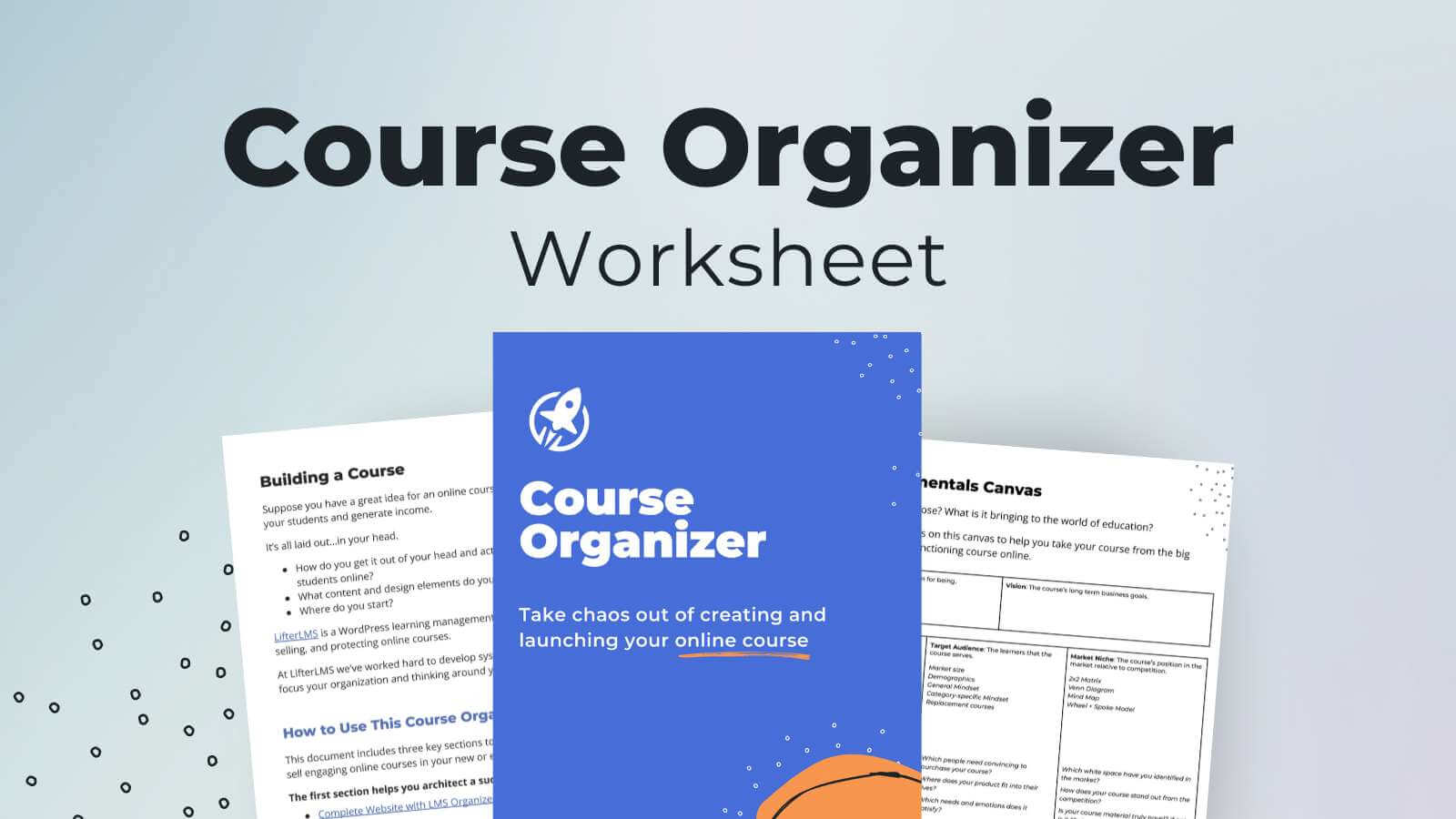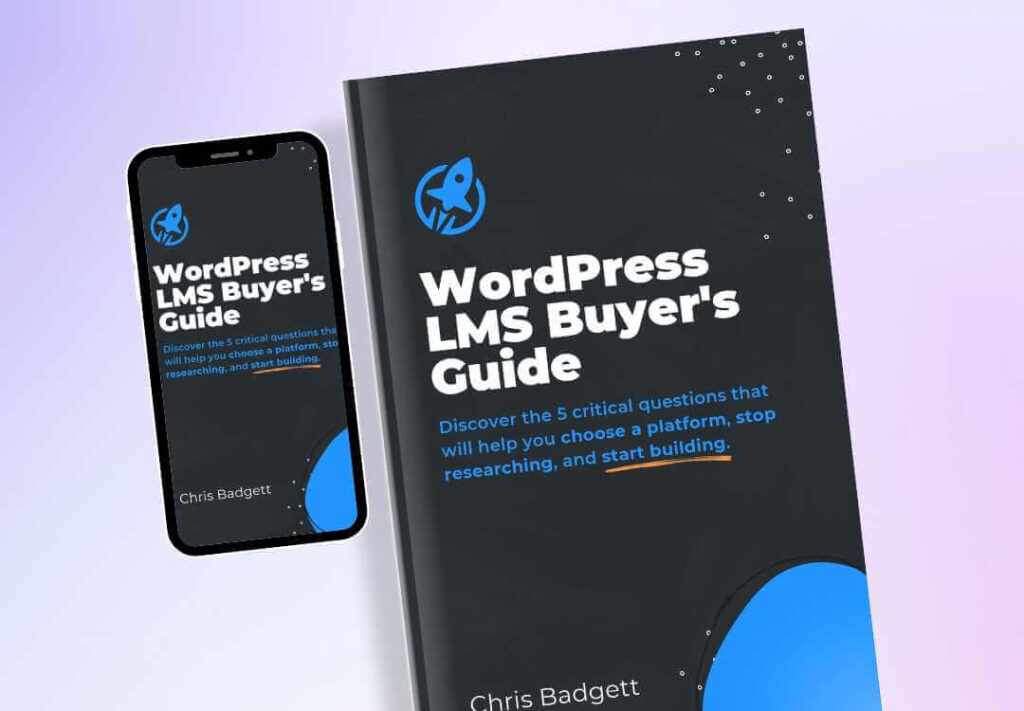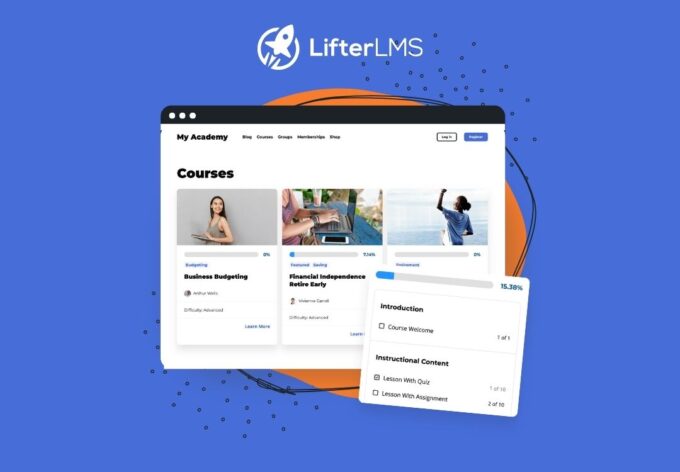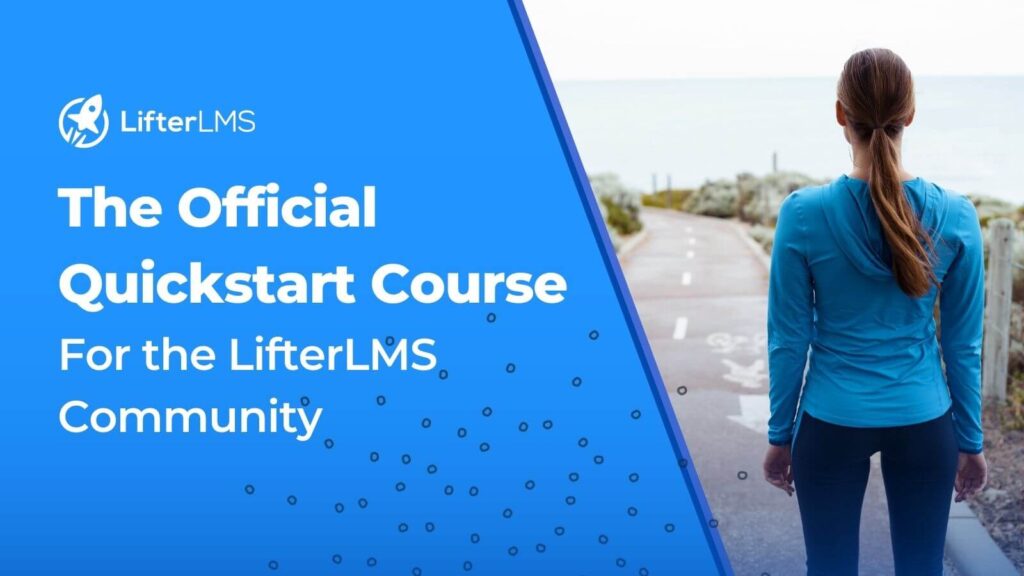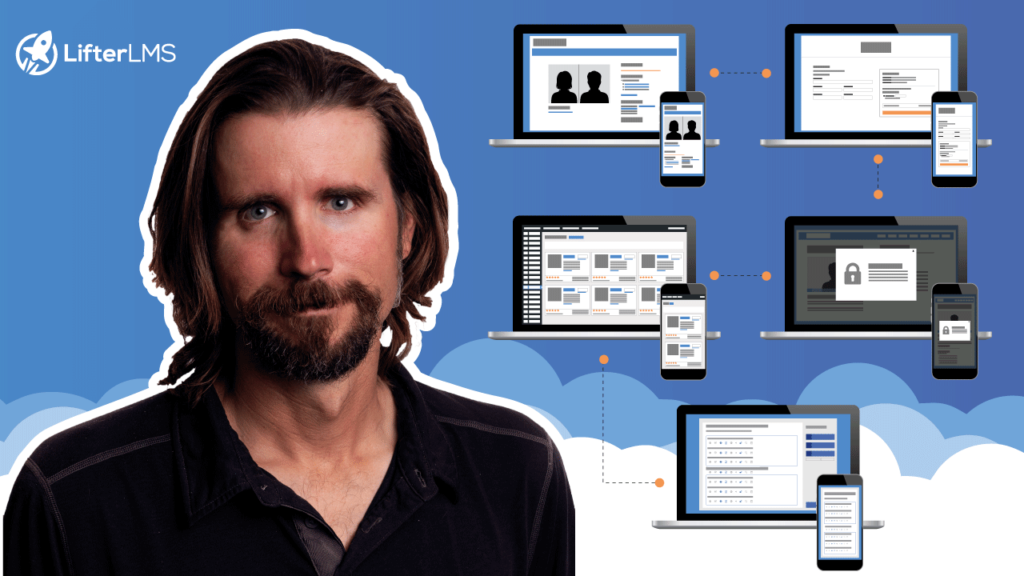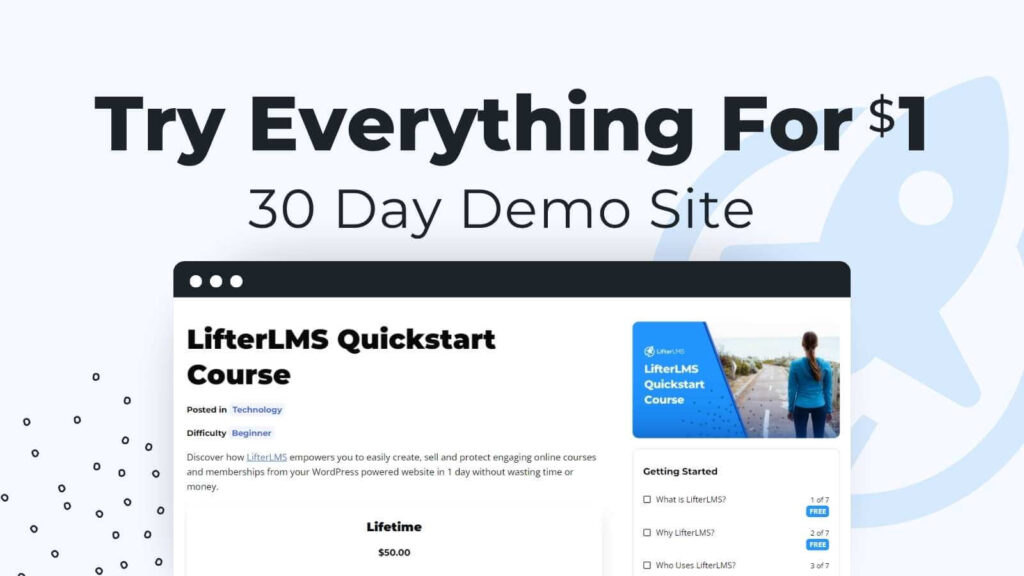This episode is brought to you by Popup Maker
Boost Your Website’s Leads & Sales with Popup Maker
Get started for free or save 15% OFF Popup Maker Premium—the most trusted WordPress popup plugin to grow your email list and increase sales conversions.
Greg Zakowicz from Omnisend offers a useful, data-driven strategy to assist course developers in expanding their audience and boosting enrollments through successful multi-channel marketing.
Greg highlights the significance of moving beyond conventional email campaigns by including SMS, online push alerts, and personalized messaging into a unified approach. Greg has more than 20 years of expertise in e-commerce and lifecycle marketing.
He describes how course developers may utilize automation to offer timely, pertinent information at every stage of the learner experience by segmenting their audiences based on behavior, such as engaged prospects, new leads, or inactive users. Greg outlines important lifecycle automation processes that are intended to increase conversion rates and student retention, such as welcome sequences, abandoned cart messages, onboarding emails, and post-purchase interaction. Additionally, he emphasizes how crucial it is to keep email lists healthy and optimize message timing to match client intent.
Creators may oversee all communications from a single location by utilizing a unified platform such as Omnisend, guaranteeing consistent message at every touchpoint.
2025 WordPress LMS Buyer’s Guide
Exclusive Download! Stop wasting time and money researching online course and membership site tech.
Here’s Where To Go Next…
Get the Course Creator Starter Kit to help you (or your client) create, launch, and scale a high-value online learning website.
Also visit the creators of the LMScast podcast over at LifterLMS, the world’s leading most customizable learning management system software for WordPress. Create courses, coaching programs, online schools, and more with LifterLMS.
Browse more recent episodes of the LMScast podcast here or explore the entire back catalog since 2014.
And be sure to subscribe to get new podcast episodes delivered to your inbox every week.
Episode Transcript
Chris Badgett: You’ve come to the right place if you’re looking to create, launch, and scale a high value online training program. I’m your guide, Chris Badget. I’m the co-founder of lifter LMS, the most powerful learning management system for WordPress. State of the end, I’ve got something special for you. Enjoy the show.
Hello and welcome back to another episode of LMS Casts. We’re joined by a special guest. His name is Greg Zow. He’s from Omnis Send. You can find Omnis [email protected]. Greg is an e-commerce and retail advisor at Omnis Send. We’re gonna go deep on marketing for LMS websites and the creators of those websites.
We’re gonna talk about marketing automation, multi-channel marketing. Changes in buying behavior and what’s going on at the macro level. But first, welcome to the show, Greg. Thanks, Chris. Super excited to be here and looking forward to a good conversation. Yeah, I’m really loving Omnis. Send Omnis send has done a lot of great things in the WordPress space, both with WooCommerce, LMS plugins, membership plugins, and the digital commerce side of things.
Let’s start at the macro. What are you seeing in terms of how spending behavior or cons, consumer behavior is changing in ways that might be relevant to course creators and coaches out there?
Greg Zakowicz: Yeah, it’s a good question ’cause we’ve been seeing it for the past 18 months and it’s finally coming to a head now.
So I’ll start from the product level and we’ll back over. Because that’s where a lot of that consumer behavior changes data comes from. We all know we live in a relatively uncertain economic time right now. Every day seems to ebb and flow a little bit here and there. But the changes have been coming, like inflation’s been around for years, so we’ve been dealing with it ever since the pandemic.
And really it’s, while they say it’s come down, it’s come down over the previous level, which was high, right? So I feel at the grocery store when I go. Buying product. So about 18 plus months ago, we started to see a shift to value focus. Private labels, right? Customer or consumers, would trade down when the value of the private labels matched, product quality or whatever it is, stores now.
Costco, target, Walmart, they’ve all expanded their private label offerings. And that’s just an example. So we were starting to see like this value focused mindset, which was groceries, it was products, it was sneakers, it was clothing, whatever. And then you had stores like Teo and stuff like that and Shane, which are facing their own problems now, at least for the US audience.
But they were contributing to that. So yeah, I can get a. Desk clamp for four bucks, why not? If it breaks in 12 months, I’m out four bucks and I’ll just buy another one. So that was the shift, and over the last probably six months, we started to see that accelerate a little bit more. So spending was still up, but what we were starting to see was the number of orders were down.
So what you would have is consumers focusing on value. So Walmart’s a good example here. If I. Start to buy a couple things at Walmart and my dollar, I need to stretch further and I get the value here. Now what I do is I start to consolidate my purchases. So spending was up, but the number of orders across the board were down.
So what we were doing is consolidating purchases. But what that tells me as. A brand as a course creator, as an agency, every sale really matters at that point because there are fewer sales to go around. You wanna capture those dollars. So average order value would go up. And then last month the report came out, came out last week, but last month we started to see consumer spending slow for the first time in almost 10 years.
So those tariffs and stuff and kind of that hesitation and concern is caught up with us. So ffr. If you’re a course creator, you’re not selling, widgets per se, where you need to worry about consolidating value, but the shopping behaviors have changed. Consumers are in this value focused mindset that’s gonna translate to everything.
Whether you’re buying a car, you’re buying gas, you’re buying a service, you’re buying you. HVAC services, right? You start to evaluate those purchases a little bit differently. And if you’re a course grader, you now need to look at, okay, this is a lens which consumers and my customers are going to order through.
Do my offerings, do my value props. All these things match that lens and can I filter that a little bit more? And that’s I know we’ll talk about this a little bit more, but that’s really what course creators and agencies should be looking at. It might not. Directly apply to them from a product standpoint.
But that lens at which those same consumers that are buying those things and have shifted their mindset, that’s the lens they’re looking through and that’s what we need to talk about and flesh out a little bit more.
Chris Badgett: Does that make sense? It does. And and I guess it’s somewhat of a controversial issue, but I’ve been thinking a lot about the cost of higher education.
I’m a fan of university and liberal arts education as an example. I’m an anthropologist, but I’m a business guy now. And I got a lot of value in university. But when you think about that value lens and the uncertainty of the world I just have this sense that course creator, subject matter experts.
Can put together offers that kind of help fulfill the promise of the quote, American dream of get good education and get a good job, or chart your course in life. It seems like there’s a lot of opportunity for course creators and as an example this was several years ago I think in 2 20 19, I was like thinking I could spend two years and get a MBA.
Or I could, work with a business coach that really understands software entrepreneurship for a quarter of the cost and it’s more focused and targeted on my domain. And I did that and it was an amazing two years. But what are some thoughts about that in terms of. Creators who want to help people get jobs or grow skills, like in a more decentralized, non-traditional higher ed fashion.
Greg Zakowicz: Yeah, it’s a real we could probably spend two hours talking about this, over a cup of coffee or something, but I’m like you, I went to college, loved my experience. Learned a lot, right? There’s a lot of growth that goes in there, especially at those ages. I’m also saving for my kids’ college now, which you talk about the cost increasing.
Holy cow. But I work in marketing, like you talk to a marketer, did you go to school for marketing? And it’s 95% of ’em did not. And I did marketing was my minor communications guy. I went to radio broadcasting, right? That was my focus. And I transitioned to marketing. I look at this and go, okay, do you need a marketing degree to work in marketing?
Absolutely not. Do you need a X, Y, Z degree to work in a different field? Some cases, yes, doctors, stuff like that. In some cases, a lot of cases, no, you don’t. Now we live in an era where YouTube is probably the best educational platform. Think about it out there, right? I replaced a fuse in the back of my dryer a couple weeks ago, which normally would have to pay a guy to come out.
And I just looked at a two minute video and bought a three minute $3 part on Amazon. I’m like, boom. Done. So we talk about courses and stuff like this and upleveling and learning new skills, and I think the, for me, we live in a, that age where, yeah, these things make sense. The more you can, the more you can learn about a specific topic industry.
Having a mentor. And then sometimes these things are important for just connecting who’s the instructor on this thing? Can I connect with them on LinkedIn and learn more and ask them questions and things like that without having to pay $20,000 a year or $40,000 a year? Do. So I think it’s great.
I think what we talk about courses. We should be like, this is a value add to me. We talked offline about this before about promoting value add, and I think this is one of those value adds. Yeah. Cost of education’s increasing, cost of everything’s increasing, and we have these less costly courses that you can still learn the same skills that will get you ahead and whether you’re full-time in your career.
Omni Send, we still do training courses and we take classes and we do stuff like that. You never stop learning. And that’s the thing. And I think that’s the one thing where people, I say this probably more so young people, and I was definitely one of these, one of those where, you get outta college and you’re like, all right.
I’ve done it, and now I just need to learn that specific role of my next job. And once I do that, and really the learning never ends. And I think that’s where chorus creators are looking at this going, okay, we have a value here that fits with what people need in a very competitive but really expensive world, and we don’t, we’re not that expensive and we still get you the same value.
It’s the one thing people never look at is, okay, I’ve got an instructor here in college that is charging me 45 grand a year to go to, and I’ve got an instructor here that maybe has the same qualifications, has charging me 400 bucks or 300 bucks or 200 bucks to do, right? I might have a little more interaction here maybe not, right?
I might have more direct access here, but. Does this person over here have so much more knowledge in this person? A lot of times, no. There’s a lot of people out there that have more knowledge than me on certain topics, and that’s fine. And it doesn’t mean that I’m not valuable. It doesn’t mean they’re not valuable.
So I think this is the one benefit that course creators have now is that. People are seeking upleveling, they’re seeking cheaper ways to do things. And it doesn’t mean those cheaper ways are any less effective or any less better. So I don’t know if that answers the initial question, Chris. I might have just skipped over the whole thing, but I went on this diatribe about education, but I think course creators sit in a really unique position now where maybe they did in 20 years ago because it was harder and even 10 years ago.
It is, you get these online universities that. You get the bad terminology when the student loan thing was happening a few years ago about these, the fake colleges and stuff like that. But I think people are smart enough to realize, hey, there’s a skill, there’s a class there.
That skill will help me. That class is good. It’s got good reviews, let me do it right.
Chris Badgett: Yeah that’s awesome. You nailed it. Let’s talk about email marketing or email automation through the lens. I think Omnis send one of the things that makes Omnis send great. Is, it was born out of the Shopify retail space.
And what can course creators and coaches learn from more of the traditional online retail email marketing and automation space. Like what tips and tricks, what transfers over quite well that course creators may not be thinking about? Yeah. This is, so this is
Greg Zakowicz: fun because 20 years ago, your B2B.
Marketing approaches and D two C were fairly different, right? You had different mediums and stuff like that, and strategies were different. And really those things are like this now, right? You might have a fringe here and there, but for the most part, those strategies are the same. You have the same consumers buying products, running organizations, making organizational decisions that are also buying a pair of shoes on the weekends.
What we’ve seen over, I would say the last 10 years, but notably in the last five years specifically was just the convergence of these. So whether I’m looking at a B2B company, their email program, or a D two C company, I’m still seeing the same things. Be more effective than others. Value of email is a first party channel, right?
And I don’t discount paid ads on paid social or paid search. I think they’re all part and necessary parts of the journey. But email is a first party channel, so you can. We get this later, but there’s ways to reduce retargeting costs using email and cutting your costs on social platforms and stuff like that.
But email is a first part. Channel SMS is the same thing. Someone willingly gives you a piece of information saying, yeah, I want to hear from you. That is gold in itself, whether it be two B or D two C, it’s perfect. The things within that we’re seeing to be most effective, we’ve been saying it for years.
I’ve been saying it, everyone’s probably sick of hearing it, but it’s still true. It doesn’t make it less true. It’s automations and. We put out these stats reported on me. Send, we have, excuse me last year, 26, almost 26 billion emails going around for a variety of customers. So we’re looking at the data.
It holds true every year. Automated messages are driving 37% of all email orders. They’re accounting for 2% of sends. Reason is they’re timely and they’re relevant, they’re naturally then sending individually. So I take an action, I get an email based on an action. That email is customized and it sends automatically, you don’t have to be awake, you don’t have to schedule it, you just need to set it up one time.
So those things are disproportionate from a revenue and it’s a send standpoint, but it doesn’t mean all automations are created equal. So this is like you’ll hear oh, send the birthday message or do this write in engages, and those. Sure they’ll engage. You’ll get high opens, but they don’t necessarily drive conversion.
So yeah, you could have, you could create a course, you can try to retarget a customer, maybe you asked their birthday ’cause you’re trying to create a connection. You send ’em and they’re like, okay, great. I got a birthday message. So what three messages that drive more than anything. And this is related to products, it related to course creators, it related, it relates to agencies selling services, welcome messages.
Browse abandonment or product abandonment, however you wanna do it, and card abandonment. So check out abandonment. Those three, whether you’re selling something, a service, those things, three things apply to you. Those will make up more than they’re roughly around 87% of all automated orders come from those three messages.
So you talk about out weight performance here. Those are the things. So if I’m a course creator I’m gonna have a popup on my website that I probably got you to my website through a paid social ad or a paid search ad. Something. So I’ve already invested money in that. So I get you to my website.
I’ve got a popup. I wanna capture that email address. ’cause now I can retarget you, right? I don’t have to spend tons. My email costs what? An email costs which is not much. So I captured that information. Now I can send you that welcome message. That’s one of ’em. That welcome message I can introduce, right?
The offerings, the value add, really promote that value on there. If I don’t get you to buy. To put something in your cart, go to the checkout page. I know at that point what you’re viewing. I know what products you’re, your pages you’re going to, so I know a level of interest there. I also have an email that welcome email where I might have links in there where I can look at and say, okay, I clicked on upleveling on marketing.
The marketing cores versus the admin course, or HR course, or whatever it is. So I can now do any sort of automation retargeting based on what you clicked or based on the pages you viewed, which is your browser abandonment, right? Viewed. So now we’re sending these things off and we can do email or SMS or both at those things.
And if I can get you to a checkout page, conference con conferences, were doing this 15 years ago. I get to the checkout page, I don’t register for the conference. I get the abandoned cart one. It’s really just a checkout abandonment one. And that’s still, that applies to, it could be agencies and it could be course graders.
So you’ve got these things that are transferrable over. But a lot of times what I find is either B2B companies, course graders, agencies, they neglect them ’cause they automatically think, ’cause they go through ’em on their personal lives, they think. Oh, this is for products. This isn’t for me. A service or I’m an offering or I’m an online product.
So it doesn’t matter. The fact is, it does, and they still work. They’re timely, relevant, and they’re based on intent. I’m on your website ’cause there’s some sort of intent there. I might not be ready to buy today, but I’m interested and that is the intent you need to follow with that stuff. It’s a long answer for you Chris, but we can dig into any one of those strategies you want.
We can dig into. Whatever you want but those are the three I hit. Welcome messages. Browse abandonment. Checkout abandonment.
Chris Badgett: This episode of LMS Cas is brought to you by Popup Maker, the most powerful, trusted popup solution for WordPress. Whether you’re selling online courses or memberships, popup maker helps you grow your email list, boost sales conversions, and engage your visitors with highly customizable popups. Imagine creating custom opt-ins, announcements and promotions that actually convert.
I personally use pop-up maker on my lifter LMS websites for lead magnet opt-ins, card abandonment, upsells, downsells in guiding users to helpful content. Pub Maker is an essential tool for growing my email list and making more money online through my website. Ready to take your website to the next level?
Head on over to wp popup maker.com/lmscast and save 15% on your order. Discount automatically applies when you visit through that link. Papa Maker also has an awesome free version, so you can just use that as well. Go to wp popup maker.com/lmscast and save 15% off your order or get started with the free version.
Now. Get more leads and sales on your website with popup Maker today. Now back to the episode.
Wow, I think you nailed that. 87% of automation orders coming through those three and. Just to put it out there, if you’re watching or listening this, you can do this easily with Lifter LMS or WooCommerce, or paid memberships Pro with Omnis Send, which integrates directly.
And you guys have like templates and all kinds of stuff to make setting this up easy.
Greg Zakowicz: Yeah, everything’s pre-built. You can customize anything you want, but we pre-built segments. We pre-built workflows based on what you want. You select it and you can. Even though it’s templatized, you can then customize the template if you want.
But the whole thing is designed to get you to build it in literally a matter of seconds to maybe a minute a couple minutes to create a message, but we even templatize the message for you so you can just customize a couple things and super easy to do. And then you can get more advanced and sophisticated as you want and slowly add and optimize it.
Chris Badgett: That’s awesome. Let’s riff on Black Friday, cyber Monday a little bit. I noticed, the software industry was looking at the retail industry and like what happened at malls and shopping centers and stuff with this craze to buy on Black Friday and Cyber Monday and all these things. And the software industry got on this bus, and particularly in WordPress, where with a very value focused buyer, black Friday typically has substantial discounts.
Lifter. LMS is an example. We make five to 10 times a normal month’s revenue during this kind of November, end of November period. And I see a lot of course creators and coaches not leveraging Black Friday or at least trying. Another thing I see, which is interesting is some people do a Black Friday campaign once and then they stop because they’re like.
They get bored of it, but I heard this quote that you’re, you may be tired of your marketing, but your market never is. Black Friday will come around like clockwork every year. But stepping back, what could course creators and coaches do, or, and even agency professionals around Black Friday to, get those massive increases in sales or perhaps tie into another event that has.
Shopping behavior kind of baked into the psyche and the cultural landscape?
Greg Zakowicz: Yeah, it’s a good question. So I love the analogy kind of you gave there, there was an old saying in radio boss told me it was like, play what you want at home. Play what they want at work. So it’s the same, like your marketing thing was always spot on with it.
It’s the exact same thing. Here’s the thing about Black Friday, cyber Monday or whatever. Keep your right if you’re back to school season, which we’re currently in right now, right? Whatever your big sales period is. We talked earlier about the lens of value focused shopping.
Nothing screams value focused shopping more than Black Friday, cyber Monday. Those, that, how those holiday deals. So whether you like offering ’em or not is one thing. You can offer ’em. People are expecting it, right? It doesn’t have to be the biggest thing in the world. And I’ll give you an example. I have a couple pieces of exercise equipment at home.
I have an iFit membership to check my workouts on and they run Black Friday deals and yearly memberships are not inexpensive. I’m a value focused shopper and they run ’em and. Every Black Friday, I go look to see what the discounts are, look at the previous year, and I will renew my membership at that point.
But it’s the subscription, but I’m looking for value on it. I don’t need to do it in June when it expires in December, and I just start stacking ’em. So the one thing I will look at is one, people are expecting some sort of value. So be in the conversation, right? It doesn’t have to be the biggest discount, but be in the conversation.
Reinforce to your audience, yes, I’m in the trend. I see you. I can offer this to you. And if you can’t offer, if everyone else is doing 40% and you’re like, you know what? I could do 10% off. That’s what we do here, right? Add onto it with focusing on value. What makes your course different and really promote 10% off for Black Friday.
So let ’em know it’s a deal. Let ’em know 10% off. Let a limited time window on there. For four days, only, five days only, whatever it might be. You can use SMS as a flash sale, two hours, maybe get 15% off, but then focus on the other values, direct access to course or have your questions answered by course creators or whatever your value props are.
And that’s how you wanna build that whole thing together. So don’t have to give away the farm. You don’t have to do 70% off. Again, you don’t have to, but you need to be in the conversation. If I’m looking at this is just consumer mentality here and the marketing psychology, but I’m looking at two courses.
One is, 50 bucks more, but they were giving me 10% off and this one is flat fee. And at the end of the day, they’re at the same price. I’m gonna look at this and go, okay, I’m gonna take the 10% off ’cause it’s priced more here and I’m getting a better deal. So inherently I think we have better value over here.
Might not be true, but if they’re not, they’re just promoting 10% off this course and I’ve got. Hey, flat fee, but we get this, and this. Now I’m looking, okay, where is that value? I’m looking through that lens. Where am I getting the best bang for the buck? And it might be on these value props here, so we need to be in the conversation with it, if nothing else.
And I think that’s the one thing to look at is, look at margins. Obviously you should have fairly decent margins, I would think if you’re a course greater because you’re not manufacturing products per se. But you need to be in the conversation. But I would promote it. I would try to do, find ways that work with your brand, work with your product, your discounting philosophy as a organization and kind of move from there for it.
But I gotta be in the conversation for it, in my opinion.
Chris Badgett: Let’s learn from retail again, and I’m hoping you can do the same thing for SMS that you did with. Email automation. Three emails welcome, email browse abandonment and card abandonment. SMS is underutilized by course creators and coaches.
Omnis send makes it easy, but at a international level ’cause a lot of course creators have people all over the world. I think a lot, there’s a misconception that. Email’s easy ’cause everybody has an email. But how do I do all this international text messaging? Omnis Send actually does, it makes it easy to the tech part and the infrastructure part of that.
But what kinds of SMS campaigns could course creators do?
Greg Zakowicz: I think give you the same answer. It’s gonna be the same messages. So what we see from SMS, just put it in perspective conversion rates, click rates on automated SMS more than double. Just scheduled messages so effective there it’s not 37 to 2%, but it’s, I think the number was 18% of all or SMS orders came from automated SMS 9% of sent, so still two to one ratio.
Again, the reason is simple. It’s relevant, it’s timely, and it’s personal to ’em. So what I would do from an SMS standpoint is look at the same ones, right? I talk, I talked a little bit about focusing on high intent messages, birthday messages, great. They can engage, but they’re not high intent. I’m not opening the email because planning on shopping, maybe I am, but.
I’m opening ’cause you’re wishing a birthday. And people like their birthdays generally, and they wanna feel good. It’s the intent, the welcome message has an intent. So send an automated SMS message. Just get in their inbox, get in their messages, slide in their dms browse abandonment.
Again, there’s a high intent there. What am I checking out? So that’s an easy place where you can just slide an SMS in there and be like, Hey, we noticed you checking out X, Y, Z. Or don’t forget, all. All new subscribers get X, Y, Z, and just have a link there, getting it back. So if they decide, 12 hours from now, they’ve got an easy place to link.
And then again, abandonment, check out abandonment. You’re so close, don’t you know? And you just promote Hey, get ahead, get that promotion, whatever that value add for taking that course is right. It’s the same three messages that I would start with, and then you can expand from there. But I don’t think you need to expand a whole lot.
Maybe. A re-engagement message if they stop logging into the course or whatever lapse purchase, stuff like that. But I don’t think you need birthday messages on SMS for a course creator. I don’t think you need, back in stock messages. You don’t only have back in stock. So really what I tell people is look at the intent of a, the customer, consumer, whoever it is, what’s their intent, and that’s where you wanna follow your messages.
So that’s the second lens that put it through. I’m sure you’ll probably ask me about it. Like we were chatting offline about this is like people are scared to jump in S mess. They either don’t know how to do it, they don’t think, for course creators, it makes sense, or agencies it makes sense. They think, oh, it’s too intimate, it’s too personal, and I’m not a fun brand, right?
I’m trying to, I’m trying to educate someone. I would say it, it’s hogwash. So the best thing to do. Is test it and how do you test it? You put ask for mobile. Ask for mobile numbers at signup. On the popup. Leave it an optional field. Do not make it required. Do not make it seem like if they get an incentive, whether it’s an ebook or a discount on the first course or whatever it is for setting up for an email address, you then go to a second step that makes it sound like they need to sign up for mobile to get that.
A lot of times they’ll say it, but they still do it. Sometimes they require it. It’s okay to have two steps. Just make that second step optional. If people sign up for your SMS, it’s an indication that yeah, they’re okay getting an SMS from you. If they don’t sign up, it’s your indication that, yeah, maybe my audience for this particular product or course it’s not their jam and that’s okay.
But that’s a simple way to figure it out. And then if you need to start, if you start to see those, estimate, those mobile numbers come in, the simple way to start is just put an SMS message in those automations we talked about. Let the automated SMS do the work, and you don’t have to schedule messages every week or every two weeks to those people until you’re ready.
Let ’em see if it works. Like my kids say, let it cook, right? That’s the simple way to start. You let the automation do it, you let it test out. If it’s not gonna work on a really high intent, ones that are proven to convert, maybe it’s your indication that yeah, they want SMS, but we don’t really have the formula for what they want from that SMS.
And you could slowly refine your automated ones until they start working, and then that gives you an indication of how to build your scheduled messages out.
Chris Badgett: Awesome. You mentioned fund brand and maybe we could use potentially the university professor versus an independent subject matter expert as an example.
This is so from like a marketing angle. How do we build, a fun brand office, authenticity, trust, and authority? Because I see a lot of people get hung up in this imposter syndrome stuff. Yeah. And in our marketing, just how can we be more authentic and authoritative and really at the end of the day, build that trust.
Greg Zakowicz: I, I think you, the word you used is authentic, right? Like I look at it from a couple, couple different ways. I’ve been in this, I’ve been in email for almost 20 years now, I think 19 plus years. I’ve been doing it for a long time. I’ve been in SMS for over a decade. I’ve been through B2B, I’ve done D two C.
I’ve done kind of all roles in it. I still suffer from imposter syndrome. I’m like, I know my stuff, but I still suffer from it, right? I think it’s natural for people. We also live in an era where the industry changes a lot, right? You think about e-commerce five years ago, it was pretty well fleshed out, but it’s so different now.
Right now we got a agent tech AI for shopping and browsing and doing all these things and it’s continually changing, and I think that’s where kind of imposter syndrome comes in. But then I look at, okay, if I’m a professor and not knocking professors here at universities, but if I’m a professor and I’m not in the actual field, I’m.
Doing coursebook and studying, lecturing off that versus here’s Greg over here who’s living in this day by day and looking at numbers and, talking to brands. Which one might be better for me, from a practical skill standpoint. And it’s probably gonna be the subject matter expert.
So it’s not really answering your question yet, Chris, but I think there’s a lot of value to being in the field day to day and figuring out, hey, this is working, this isn’t working. But it used to. And it’s less theory, it’s more practical. And I think the practical skills sell how to build it. I’m really bad at building things like this.
Just personally it takes a lot of time and I’m not a course creator, but YouTube, we talked about being I mentioned as the greatest educational tool out there. Right now. You got other ones like Khan Academy and other courses. But collectively, YouTube is awesome. So you have the ability to build.
Short videos and things that kind of reinforce it there. You can be more fun on YouTube. You don’t have to be stuffy. TikTok, Instagram, whatever social channels you wanna use, you can be a lot more fun and build the authenticity there. You can write bylines for, industry articles, whatever you want.
So I think it’s just a collective effort. It’s a lot of work. It’s a lot of, it’s a collective effort there to, but you have the ability where. People don’t care if you’re, suit and tie professional anymore. For the most part. They care that whether you know your stuff and you can relate that content transferable and they trust you.
And I think that’s the biggest thing. And you build trust by, say say what you’re gonna do and then do what you say it’s the same thing, right? If I’m telling you that automation is awesome and everyone’s automation stinks, they’re gonna be like, this guy doesn’t know what he is talk about, but we see the automation work and now.
We can see which ones work or whatever. So it’s all about just building trust and having fun and smiling and, self-deprecating when it matters. You know your audience best and what type of course you’re building, but be relatable. And that’s really the biggest thing.
Chris Badgett: Question about Omnis.
Send email marketing platforms and multichannel marketing platforms. They’re a little sticky. But I’ve noticed every two to three years people start, getting frustrated with their current setup. And maybe they’re starting to shop around and looking to switch.
If somebody’s looking to start or switch with, switch to Omnis, send particularly around this idea of, welcome automation, browse, abandonment, automation, card abandonment automation. What’s the best way to get started and why should they take a hard look at Omnis Send.
Greg Zakowicz: Yeah. Best way to get started, I think for anyone, regardless of the type of platform, is to understand what else is out there.
So you look at your own capabilities okay, what are we lacking that we need? Why do we think we need that? So you gotta figure out what you’re missing, right? And it could be the platform is not advancing. We got ai, but the platform doesn’t have any AI in it. And now I’m using three tools to get one thing done.
So you gotta figure out what you’re lacking, why you’re lacking, and then. What you want on the next platform. That’s the easiest thing to do. It’s not always easy, but that’s the simplest place to get started. And then when you start looking at what else is out there, you have to look at the platforms.
Do they have these things? And what else did the platform offer beyond these core things? So I think every platform in the world has features that most people aren’t going to use. You get the 80 20 rule, or, 90 10, whatever they want, where, 20% of the features used by 80% of the people.
But do they have the ability to have the features? Should you grow into ’em as you scale? Can they meet your scaling needs? And when you look at that, I point you back to Omnis sound, but the platform is just good. I’ve been in, in the email email marketing and SMS platform space for 13, 14 years now.
The platform’s good. We have AI built into things you can. Generally talk about segments you wanna build and they’ll build a segment for you, right? So it’s small things like that. We talked about automation. Do they have automation? Is it customizable and is it gated? Now, that’s an important thing too, because you’ll have email providers that say, Hey, we have all these things.
You go on there and you get this cheap plan. It’s oh, you gotta get the enterprise plan to get these things. So look to see what’s gated and what’s not. And that’s gonna be an important thing. Our automations, you could be at our free plan, you can use the automations. You gotta figure out that stuff out.
Does it integrate with your platform? So WooCommerce WordPress, do you have an integration that syncs the data? ’cause that’s gonna be important then what other tools? Right? Popups. Okay. Popups built in. I can use ’em, I can choose not to use ’em, but it’s there for me if I want to. Do they have testing with the popups?
Do they have segment builders? Do they have, like what’s the email builder like what I, when we talk about like why should you use Omnis send, we just check the boxes, we follow the industry trends, we build it into the platform. We integrate very quickly on these things. We take customer feedback and that’s the one thing I will say about Omnis Send versus others.
We’re organically funded, so if we don’t have investors to report to, we have our customers to report to. And if we’re not providing a value to our customers, they’re not gonna choose us. They choose us, get 125,000 happy customers. It’s just a really solid platform. When you’re looking, go talk to someone there.
You can sign up for Omnis, send for free. You don’t have to put a credit card down. So if you wanna just play around with it, go sign up, play around with it, integrate it, do what you wanna do and see if it works for you and see if those customizations. Reaching out to the company a lot of times will give you a sense of.
Are they business oriented? Are they customer oriented? Are they fun to talk to? Are they very stuffy? A lot of times just having a conversation with someone’s easiest way word, approachable team over here.
Chris Badgett: That’s awesome. That’s Greg Zow, e-commerce and retail advisor at Omnis Send. Is there anywhere else people can connect with you online?
Greg Zakowicz: Yeah, usual places. You can find me on LinkedIn. I’m on Blue Sky more than Twitter now. Not many people are on Blue Sky, but I’m over there. If you go to my Twitter, you can link over, but LinkedIn’s probably the best place you can find me. Anyone else on Omnis Sun there? Omnis Sun as well. They’re pretty active on social too, so just feel free to pop over.
We’re friendly.
Chris Badgett: Awesome Greg. Thanks for coming on the show. I could have talked for hours with you on marketing, but it’s been a great conversation. Really appreciate it.
Greg Zakowicz: I appreciate the invite and thanks for having me Chris. I enjoyed as well.
Chris Badgett: And that’s a wrap for this episode of LMS Cast. Did you enjoy that episode? Tell your friends and be sure to subscribe so you don’t miss the next episode. And I’ve got a gift for you [email protected] slash gift. Go to lifter lms.com/gift. Keep learning. Keep taking action, and I’ll see you. In the next episode.
2025 WordPress LMS Buyer’s Guide
Exclusive Download! Stop wasting time and money researching online course and membership site tech.



